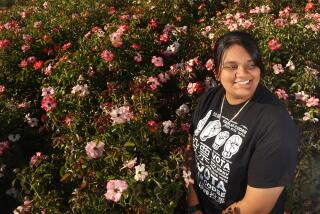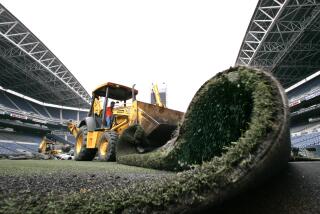‘Grass-Cycling’: An Antidote to Environmentally Incorrect Lawns
- Share via
The suburban lawn has long been the main preoccupation of the homeowner during the summer. Lawn wars--the fight for the best-looking green on the block--are legendary, as are the battles against the occasional misguided individual who tries to buck convention by letting a lawn go or sowing it with wildflowers.
This uniquely American lawn fixation has led to a pattern of behavior that, environmentalists believe, has made lawns dependent on their keepers for their survival.
“We have to begin a process of weaning,” said Joe Keyser, program specialist for the Department of Environmental Protection in Montgomery County, Md.
The drive to change lawn-care practices--once the domain of environmental groups--has been embraced by the establishment for all kinds of environmental reasons, not least the disappearance of landfill space.
Keyser has organized a program called “grass-cycling” aimed at altering long-ingrained lawn habits in his suburban jurisdiction.
Keyser’s arguments are compelling: Lawn and yard waste account for a third of what goes into the average landfill. The average 1,000-square-foot lawn requires 100,000 gallons of water to maintain.
Billions are spent each year on petroleum-based fertilizers, damaging herbicides and toxic pesticides. Gasoline-powered mowers represent a major source of air and noise pollution in normally quiet areas.
Keyser wants an end to the labor-intensive, environmentally inappropriate lawn. His previous crusade was in the related gardening practice of composting, which he championed for several years at the American Horticultural Society.
As for the lawn, he has a lot of tips on how to do things differently, beginning with altering human behavior.
“Get used to having your grass taller,” Keyser starts with.
To Keyser, the idea of removing from the earth of the backyard as rich and vital a source of organic material as grass clippings and choking a landfill with them, where they might take decades to decompose, is worse than wrongheaded. It is criminal.
“Think about how much you can help your lawn with all that nutrient-rich stuff you’re just wasting,” Keyser said. “You’re putting a very fine layer of mulch over lawn roots as you mow if you leave the clippings on there: water conservation.”
The issue of watering goes to the heart of lawn dependency. Conventional wisdom states that a yard needs a minimum of an inch of water per week to stay green and healthy.
But it doesn’t have to stay green to stay healthy. Many lawns, typically made up of cool-weather grasses such as fescues and bluegrass, go dormant in midsummer. They stop growing: no growth, no need for water.
Watering the lawn promotes the cycle of dependency. Grass roots fail to delve deeper for moisture, remaining close to the surface of the soil. Should the water supply ever cease, the roots are not positioned to draw on reserves. It’ll be much more stressed than a lawn that didn’t have regular watering.
Keyser advises not watering the lawn until it loses its sheen.
“If your lawn has developed brown areas from drying out, don’t bother watering it at that point; it won’t help,” Keyser says. It’ll need to regrow from the surrounding, healthy area, which might take a few weeks of cool, moist weather.
“Fertilize once a year,” Keyser said. “And only in the fall--October. Fertilizing in the spring is the worst.” Always use organic fertilizers; ignore conventional advice about “controlled-release” synthetic fertilizers.
Like watering, fertilizers trigger the cycle of dependency. A lawn that is overfed--that is, more than once a year or with potent synthetic fertilizers--is hyperkinetic. It’ll exhaust you, and, even if it doesn’t, it’ll exhaust the environment.
His last bit of advice? “Get rid of it,” he says sweetly.






